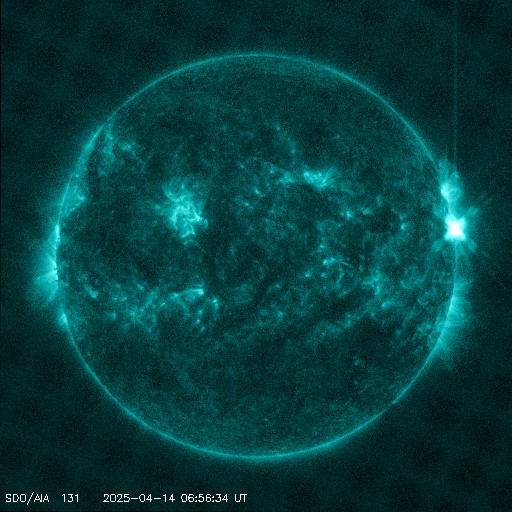Viewing archive of Sunday, 31 July 2005
Solar activity report
Any mentioned solar flare in this report has a scaling factor applied by the Space Weather Prediction Center (SWPC). Because of the SWPC scaling factor, solar flares are reported as 42% smaller than for the science quality data. The scaling factor has been removed from our archived solar flare data to reflect the true physical units.
Report of Solar-Geophysical Activity 2005 Jul 31 2224 UTCPrepared by the NOAA © SWPC and processed by SpaceWeatherLive.com
Joint USAF/NOAA Report of Solar and Geophysical Activity
SDF Number 212 Issued at 2200Z on 31 Jul 2005IA. Analysis of Solar Active Regions and Activity from 30-2100Z to 31-2100Z
Solar activity was moderate during the last 24 hours.
Region 792 (N12E38) produced today's only M-class event, an M1 at 1224 UTC.
The group produced additional B-class events during the day. This
region does not appear to have changed very much during the past 24
hours; it continues to be the largest on the disk and is a compact
group of spots with a beta-gamma-delta magnetic classification.
Region 791 (N12W62) produced a C7/Sf at 0932 UTC but was otherwise
quiet and stable. Two new regions rotated into view today: Region
794 (S11E73) and Region 795 (N15E77). Both appear to be simple
H-type groups at this time.
IB. Solar Activity Forecast
Solar activity is expected to be
moderate with Region 792 as the most likely source for activity.
There continues to be a chance for isolated major flare activity out
of 792.
IIA. Geophysical Activity Summary 30-2100Z to 31-2100Z
The geomagnetic field was mostly quiet during the past 24 hours. The
greater than 10 MeV event that began at 27/2300 UTC and reached
maximum of 41 PFU at 29/1715 UTC continues in progress but was
slowly declining during the day. The greater than
2 MeV electron flux reached high levels during the past 24 hours.
IIB. Geophysical Activity Forecast
The geomagnetic field is
expected to become mostly active with a chance for isolated minor
storm periods for 01 August due to the arrival of a glancing blow
from the X1/CME of 30/0635 UTC. Conditions should decline to
unsettled with occasional active periods for 02 August and should
be predominantly quiet on 03 August.
III. Event Probabilities 01 Aug to 03 Aug
| Class M | 75% | 75% | 75% |
| Class X | 15% | 15% | 15% |
| Proton | 20% | 20% | 20% |
| PCAF | yellow | ||
IV. Penticton 10.7 cm Flux
Observed 31 Jul 110 Predicted 01 Aug-03 Aug 115/115/110 90 Day Mean 31 Jul 096
V. Geomagnetic A Indices
Observed Afr/Ap 30 Jul 011/016 Estimated Afr/Ap 31 Jul 007/015 Predicted Afr/Ap 01 Aug-03 Aug 020/025-015/015-007/005
VI. Geomagnetic Activity Probabilities 01 Aug to 03 Aug
| A. Middle Latitudes | |||
|---|---|---|---|
| Active | 40% | 35% | 20% |
| Minor storm | 25% | 15% | 10% |
| Major-severe storm | 10% | 05% | 05% |
| B. High Latitudes | |||
|---|---|---|---|
| Active | 30% | 30% | 20% |
| Minor storm | 30% | 20% | 10% |
| Major-severe storm | 15% | 10% | 05% |
All times in UTC
Current data suggests there is a slight possibility for aurora to appear at the following high latitude regions in the near future
Gillam, MB, Iqaluit, NUNuuk
Latest news
Latest forum messages
Incoming & Unnumbered Active Regions 1702Filaments and prominences 612025/04/12-13 Filament CMEs 2025/04/16 G2 Watch 41AR 4055 99Unspecified geomagnetic activity 2258
More topicsSupport SpaceWeatherLive.com!
A lot of people come to SpaceWeatherLive to follow the Sun's activity or if there is aurora to be seen, but with more traffic comes higher server costs. Consider a donation if you enjoy SpaceWeatherLive so we can keep the website online!

Latest alerts
Monday, 14 April 2025
23:15 UTC - Geomagnetic activity
Active geomagnetic conditions (Kp4) Threshold Reached: 23:01 UTC
07:09 UTC - Solar flare
Moderate M4.28 flare from sunspot region 4055
06:48 UTC - Radio Blackout
Minor R1 radio blackout in progress (≥M1 - current: M1.53)
06:24 UTC - Solar flare
Moderate M1.49 flare from sunspot region 4055
06:06 UTC - Radio Blackout
Minor R1 radio blackout in progress (≥M1 - current: M1.16)
Space weather facts
| Last X-flare | 2025/03/28 | X1.1 |
| Last M-flare | 2025/04/14 | M4.2 |
| Last geomagnetic storm | 2025/04/06 | Kp5 (G1) |
| Spotless days | |
|---|---|
| Last spotless day | 2022/06/08 |
| Monthly mean Sunspot Number | |
|---|---|
| March 2025 | 134.2 -20.4 |
| April 2025 | 132.1 -2.1 |
| Last 30 days | 130.6 -13.6 |





